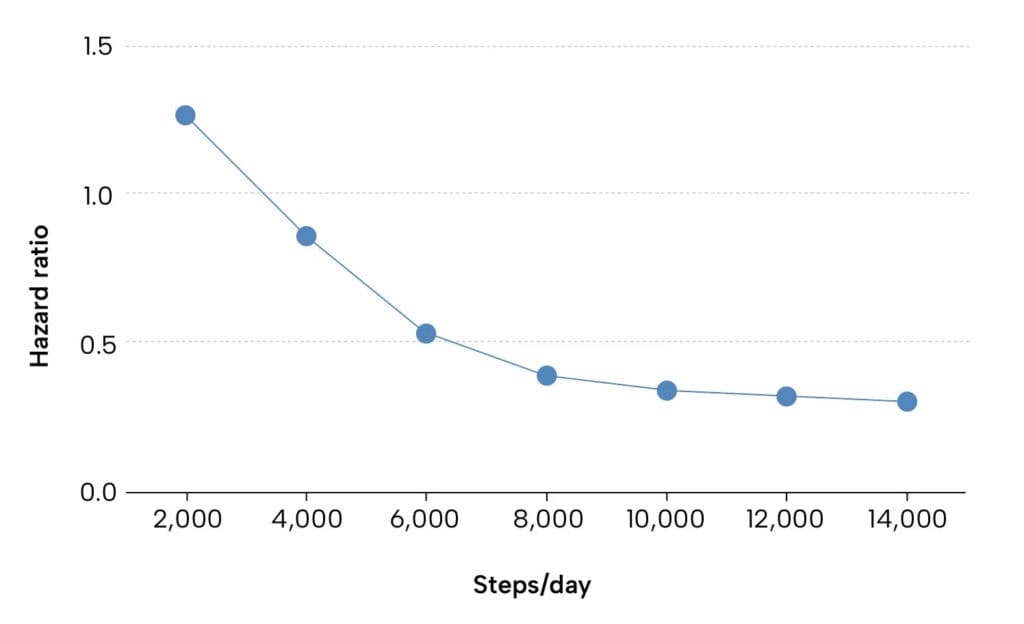Quick note: this post is taken from the Vitamin. Every Thursday, I drop some knowledge bombs on your face to help you reach your goals faster while avoiding all the bullshit.
Okay, yes. I know, I know. I’ve written a lot about step counts. However, this new study 1 was a very thorough review and analysis of the research on the topic so far, and I thought it was worth discussing to help give us a better idea of how many steps we should be taking. So let’s get into it.
What did the researchers do?
This study was essentially two reviews in one.
The first was an ‘umbrella review’, where existing systematic reviews and meta-analyses on step count and mortality risk were analysed to get a high-level summary of where the research stands on the topic so far.
The second was a meta-analysis of prospective cohort studies, in which a group of people are followed over time to see if there’s a relationship between exposure (step count) and outcome (mortality).
Umbrella review:
- This included 11 systematic reviews with meta-analyses published between 2020 and 2023.
- The duration of follow-up varied from 2 to ~13 years, and the number of studies included in each systematic review ranged from 4 to 15, with ~18,000 to ~133,000 participants. Between ~800 and ~5,400 deaths were recorded, and participants were aged between 45 and 79.
Meta-analysis:
- This included 14 prospective cohort studies published between 2015 and 2024.
- The follow-up periods for these studies ranged from ~3 to ~11 years, with an average of about nine years. Collectively, the studies included 119,436 participants (~51% were female) and 5,466 deaths were reported. The participants’ ages ranged from 45 to 78.
There were a bunch of analyses conducted, like:
- Continuous step counts (i.e. the number of steps that were taken each day) and step categories (e.g., 5000-7000 steps)
- Dose-response meta-analysis: How different number of steps affect the risk of death
- Increment of 1000 steps: How much did the risk of death decrease when steps were increased by 1000 steps/day?
- Physical activity categories: How do steps impact the risk of death when categorised into five different levels (e.g. sedentary to highly active)?
*Note: The researchers looked at several other outcomes, but the above four are the only ones I’ll look at in this email. The paper is open-access if you want to nerd out.
Results
The analysis showed an inverse relationship between daily steps and the risk of death.
In other words, more steps were linked to a lower mortality risk. However, this relationship was nonlinear, meaning the initial increases in steps led to significant reductions in mortality risk, but these benefits tapered off as the step count continued to increase.

Optimal Dose:
- The optimal number of steps per day per day to reduce the risk of death was found to be between 7,000 and 9,000.
Minimum Protective Dose:
- The minimum number of steps needed to start seeing a protective effect against the risk of death was 3,143 steps per day.
Increment of 1000 steps/day
The meta-analysis also found that each additional 1,000 steps per day was associated with a 9% reduction in the risk of death from any cause.
However, this varied depending on age. Younger adults (<70 years) saw a 5% reduction in mortality risk for each additional 1,000 steps/day, while this increased to 15% for older adults (≥70 years).
Physical activity categories
In a separate analysis, the researchers explored how different levels of daily steps impact the risk of death compared to a sedentary lifestyle (<5000 steps/day).
- For those with low activity levels (5000-7499 steps/day), the risk of death was reduced by 39% compared to those walking fewer than 5000 steps/day.
- The somewhat active group (7500-9999 steps/day) saw a 55% reduction in mortality risk compared to those walking fewer than 5000 steps/day.
- Those in the active category (10,000-12,500 steps/day) saw a 64% lower risk compared to those walking fewer than 5000 steps/day.
- The highly active group (≥12,500 steps/day) benefitted from a 65% reduction compared to those walking fewer than 5000 steps/day.

What does this all mean?
The main finding was the optimal range for maximum benefits was around 7000 to 9000 steps per day. However, even modest increases in step count significantly reduced mortality risk, with protective effects starting at around 3,000 steps per day.
That being said, there was some variation within these values depending on age. For younger adults (<70 years), the benefits plateaued at 8,000-10,000 steps/day, while older adults (≥70 years) continued to see benefits beyond this range. The minimum protective dose for younger adults was about 4,000 steps/day, whereas it was about 2,500 steps/day for older adults.
A lot of people fall into the trap of associating more with better. In the case of step counts, this is generally true. For example, in this study, going from ~3000 steps/day to ~14,000 steps/day was associated with a 70% reduction in the risk of all-cause mortality. However, it’s very unlikely that someone who’s currently hitting ~3000 steps/day is suddenly going to start walking 14,000 steps/day consistently.
Instead, it’s more common to see people gradually increase their steps, jumping from one step ‘bucket’ to the next (e.g. 3000-5000 steps/day to 5000-7000 steps/day). Therefore, it’s worth contextualising what an incremental increase in step count translates to in terms of risk reduction.
To set the scene, the reference value for the total sample was 3,143 steps per day, meaning ~3,000 steps per day were used as a baseline value against which the other step counts were compared. A hazard ratio of 1.0 is assigned to the reference value (a hazard ratio of 1.0 means no difference in risk compared to the baseline, while a hazard ratio greater than 1 indicates increased risk and less than 1 indicates reduced risk).
Here’s a table from the study showing a breakdown of different step counts and the associated hazard ratio (along with the 95% confidence interval in brackets).

Based on this study’s findings, someone walking 2,000 steps per day has a 27% increased risk of all-cause mortality compared to someone walking ~3000 steps. Going from ~3000 steps per day to 6,000 is an almost 50% reduction in the risk of death. Going from 6000 to 8000 steps is a ~26% reduction in the risk of death, and going from 8000 to 10,000 steps is a ~13% reduction in risk.
You can run dozens of scenarios and combinations, but the point is that once you’re doing about 6,000-10,000 steps, you’re getting most of the health benefits. Doing more steps will confer additional benefits, but you’re looking at marginal gains for a much larger time commitment. That being said, and assuming the relationship between step count and risk of mortality is causal, aiming for 8,000-10,000 steps is probably the ‘safer than sorry’ approach.
It’s hard to see how much the benefits level off just by looking at that table. But if we plot these hazard ratios on a graph (see below), you can see how steeply the risk levels off after about 8,000 steps/day.

Sure, the risk continues to decrease up to 14,000 steps/day, but could anyone argue there’s that big a difference going from 10,000 to 14,000 steps/day? Hell, even going from 8,000 to 10,000 steps is barely noticeable.
The other point worth highlighting is that doing something will always be better than doing nothing.
This study found each 1000-step increment led to a 9% reduction in the risk of death. So if you’re someone who struggles to get enough steps each day, instead of freaking out about hitting 10,000 steps/day because you think your heart’s going to peace out, you should focus on increasing your steps a little bit more than whatever you’re doing right now. So, if you’re averaging 3000 steps per day, well, I dunno, maybe get off your ass and move a little bit? Lol jk (but seriously), you could aim to get this up to 4000-5000 steps. Once you can comfortably do this, you could slowly work up to 8000 steps (and more if you want).
As I’ve said before, steps are a proxy for overall activity. So, if you’re already physically active, you could likely get away with doing fewer steps than someone who’s sedentary. Moreover, intensity seems to matter far less for general health than simply getting enough physical activity each week. 2
But what is ‘enough’?
Based on the current guidelines, adults should aim for 150–300 min of moderate-intensity or 75–150 min of vigorous-intensity physical activity (or an equivalent combination of the two) per week. 3
If you’re freaking out after hearing ‘moderate’ and ‘vigorous’ intensity, it’s worth mentioning a brisk walk (3-3.5 miles/hour) is considered ‘moderate’ intensity. So, just ~20 mins of brisk walking every day means you’ve hit the lower end of these recommendations. If you throw in 1-2 longer walks during the week (60-90 mins), you’ll end up closer to the higher end (300 mins/week).
TL;DR
- This was the latest study to examine the relationship between step count and all-cause mortality risk.
- The results suggest the optimal range for maximum benefits was around 7000 to 9000 steps per day.
- While more steps reduce the risk of all-cause mortality, the benefits diminish quickly after about 10,000 steps/day.
- Even modest increases in step count significantly reduced mortality risk, with protective effects starting at around 3,000 steps per day.
- If you’re doing less than 6000-10,000 steps each day, try to slowly work your way up to this amount. An additional 1000-step increase was associated with a 9% reduction in the risk of all-cause mortality, suggesting that even small increases in physical activity and movement can positively affect your health.
- Assuming the relationship between step count and mortality risk is causal, and you wanted to optimise things, aiming for 8,000-10,000 steps is probably the ‘safer than sorry’ approach.
- If you prefer a time-based approach, 150–300 min moderate-intensity or 75–150 min vigorous-intensity physical activity (or an equivalent combination of the two) per week will provide near-maximum health benefits.
Thanks for reading. If you enjoyed this, you’d love the Vitamin

95% of my new content is only sent to my email list. One email every Thursday, filled with actionable, evidence-based fitness advice to help you with your goals. If you enjoyed this, you’ll love my emails. You can learn more and subscribe for free here.